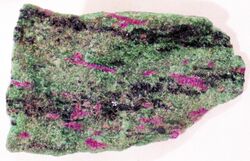Chemistry:Anyolite
Anyolite is a metamorphic rock composed of intergrown green zoisite, black/dark green pargasite and ruby.[1] It has been found in the Arusha Region of Tanzania and in Austria.[1] It is sometimes incorrectly advertised as a variety of the mineral zoisite. The term anyolite is, however, not an officially accepted term for a metamorphic rock.[2] Its name derives from the Maasai word anyoli, meaning "green".[1] Anyolite is also referred to as ruby in zoisite, ruby zoisite, ruby-zoisite or Tanganyika artstone.
The contrasting colours make anyolite a popular material for sculptures and other decorative objects. It was first discovered at the Mundarara Mine, near Longido, Tanzania in 1954.
In 2010 it was suggested that a 2 kilogram stone known as the Gem of Tanzania owned by the defunct company Wrekin Construction and fraudulently valued at £11 million was actually a lump of anyolite worth about £100,[3] although it was eventually sold for £8000.[4] It is reported that the stone originally came from a mine near Arusha, Tanzania.[5]
References
- ↑ 1.0 1.1 1.2 http://www.mindat.org/min-27151.html Mindat
- ↑ Metamorphic rocks, A classification and glossary of terms, D. Fettes and J. Desmons ed., Cambridge University Press
- ↑ Jonathan Guthrie (October 1, 2009). "Now £11m Gem of Tanzania hits rock bottom". Financial Times. http://www.ft.com/cms/s/0/f8f46cfe-ae22-11de-87e7-00144feabdc0.html.
- ↑ "Wrekin's '£11m' Gem of Tanzania ruby sold for £8k". BBC News. 16 February 2010. http://news.bbc.co.uk/1/hi/england/shropshire/8518242.stm.
- ↑ Guthrie, Jonathan; Pearson, Samantha (27 March 2019). "The strange journey of the 'jinxed' jewel". Financial Times. https://www.ft.com/content/74f14930-1b07-11de-8aa3-0000779fd2ac.
External links
- Jonathan Guthrie (December 17, 2009). "Ruby rises from rock bottom". Financial Times. http://www.ft.com/cms/s/0/da6a2ce0-eb46-11de-bc99-00144feab49a.html. Retrieved 2010-01-17.
 |


